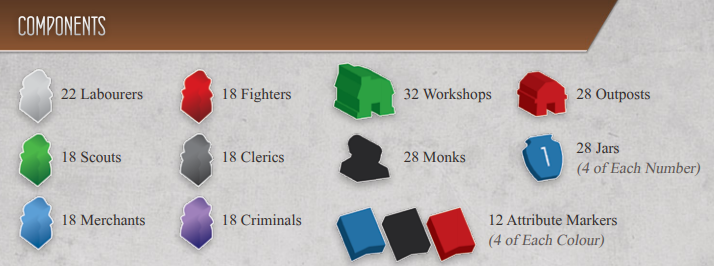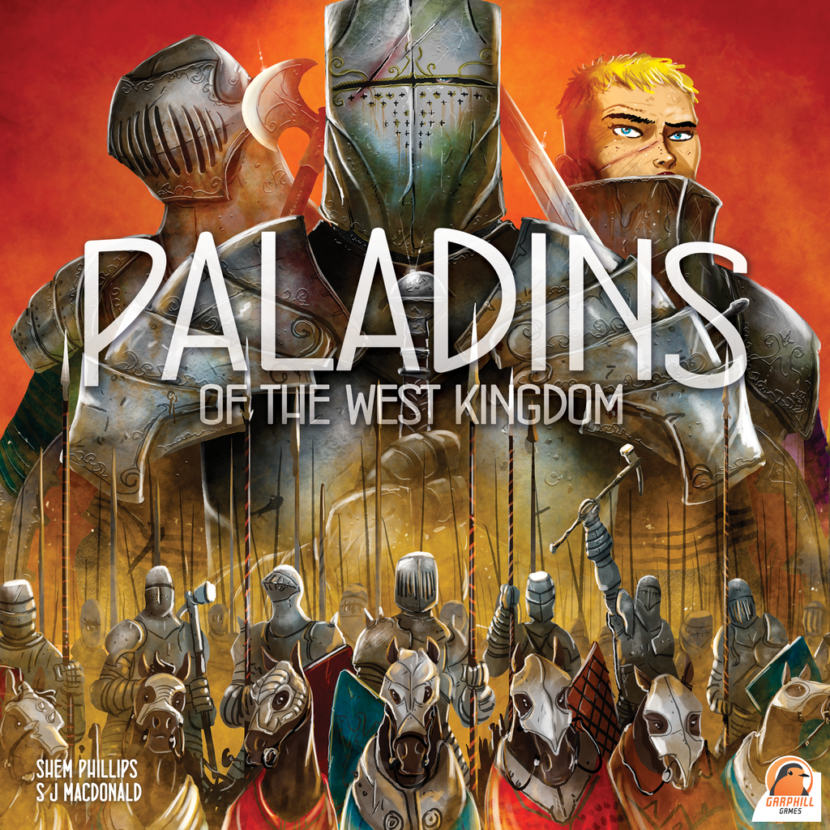In March of 2019, Paladins of the West Kingdom by Garphill Games raised nearly a million New Zealand dollars (around $600,000 USD) on Kickstarter. Ever since then, Paladins of the West Kingdom has been on the Board Game Geek Hotness list nearly every time I’ve checked. For this reason, we are going to dig into what makes this game so successful.
Looking for more resources to help you on your board game design journey?
Here you go: no email required!
Like this writing style?
Check out my latest blog on marketing here.
But first, here’s a brief explanation of how the game works, taken from the Board Game Geek page:
The aim of Paladins of the West Kingdom is to be the player with the most victory points (VP) at game’s end. Points are gained by building outposts and fortifications, commissioning monks and confronting outsiders. Each round, players will enlist the help of a specific Paladin and gather workers to carry out tasks. As the game progresses, players will slowly increase their faith, strength and influence. Not only will these affect their final score, but they will also determine the significance of their actions. The game is concluded at the end of the seventh round.
1. Board gamers really like themes set in certain time periods.
When you’re making a fantasy board game (or novel), some time periods draw more attention than others. Think of all the fantasy books set in the Middle Ages. That time period is used as the setting for many stories at least partly because readers like and expect it. This is just as true with board games.
This may seem like a pretty superficial point to analyze regarding Paladins of the West Kingdom, but it’s really not. When board game publishers set out to either create a game from scratch, publish an existing game, or retheme an existing design, they do not do so arbitrarily. They look at many possibilities and make a determination based on market demands. Then they create a game that meets those demands, in short, assuring product-market fit.
If you’re a board game designer looking to make a financially successful game, one good place to start is by researching the market. Pay attention to what board gamers like. Look for repeating patterns of consumption. From there, you can make a game that fits within a defined, tested niche of the market while still applying your own personal touches to it.
2. Custom wooden pieces add component variability to the game without inflating cost.
This is a simple lesson, but an important one. A quick look at the Paladins of the West Kingdom rulebook reveals that there are nearly FOUR HUNDRED wooden parts included in every game.

Having so many wooden components gives players the sense that they are getting a great deal. And, indeed, wooden components add a lot to the tactile experience of the game.
However, in my experience with the creation of Tasty Humans, I’ve found that individual wooden pieces are often very cheap. Sometimes as little as $0.03 each even for custom wooden components. That means you can add a lot of them to a board game without driving the cost up too much!
3. Establishing intellectual property takes a long time, but makes selling new games easier in the long run.
Anyone who’s been watching board games for a while has likely noticed the rise of “intellectual property.” That is to say, games that fall within a larger series. The principle is the same as Marvel movies – create individual movies that cohere together into a massive whole.
From a quality perspective, there are pros and cons to focusing on series of games instead of individual games. Some people find the steady delivery of new games with a similar theme to be comforting. Others find it to be stultifyingly repetitive.
From a business perspective, though, it makes perfect sense to create series of games instead of individual games. You can reuse the same brand, the same mailing list, the same audience, and many of the same art assets when creating new games within a series. You can’t do that when your business model depends upon the steady creation of brand new one-offs.
So how does this tie into Paladins of the West Kingdom? It’s simple. Paladins of the West Kingdom is part of a series of games that includes Architects of the West Kingdom and stylistically similar games Raiders of the North Sea, Explorers of the North Sea, and Shipwrights of the North Sea.
This is a rising trend in the board gaming world. Other examples include Scythe: Rise of Fenris and Founders of Gloomhaven. What’s more, board games draw heavily from fantasy and science fiction, which have been series-based since Lord of the Rings and Dune respectively.
4. Some gamers love making lots of decisions, but your theme has to set expectations to attract the right audience.
Many game designers see theme as having two primary objectives.
- Draw players in.
- Keep players engaged with the experience.
These two objectives are very important, and indeed, make board games worth playing. There is an underrated objective with game theming that many people often miss. That is: setting expectations.
For all the talk of accessibility in board games, sometimes you want to make an experience that isn’t for everyone. Gamers have described Paladins of the West Kingdom as being a game full of decision-making. For some people, this is amazing. Many of the best board games of all time are full of complex decision-making. But for some people, it’s a special circle of hell.
So what is a game creator to do? You use a theme that only attracts the type of gamers you want to attract. By using terms like “paladin” and showing medieval armor on the box, Paladins of the West Kingdom – and I say this with love – brands itself as a nerd game. That’s good – because with a weight of 3.63/5.0 on Board Game Geek, this is not a game for casual players.
Final Thoughts
Paladins of the West Kingdom is a good game for teaching board game creators how the board game market works. By looking closely at its financial success, we see the importance of theme both for attracting some gamers and repelling others. We also see the value of going all-in on wooden components and multi-game world-building.
And it does this all by being an enjoyable game on its own merits 🙂






0 thoughts on “4 Lessons from Paladins of the West Kingdom for Aspiring Board Game Designers”
I see theme as fitting in to one of two categories, abstract theme (Paladins series, Euphoria, Ken Follet series, Ticket to ride) and representational themes (Pandemic, Sherriff of Nottingham, Viticulture), sometimes themes don’t matter but this doesn’t mean a game is eluding such as in Great western trail which is simply a redesign of monopoly. But there are also games which need a specific theme in order to be successful, Robinson Crusoe comes to mind here. Theme matters most when designing around specific information about cultural institutions in how we associate it. “Romanticism” or “Taboo” associations are the first two that comes to mind when looking at the majority of successful marketing campaigns for a game.